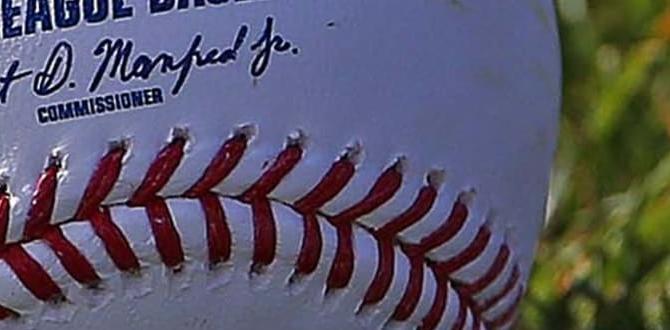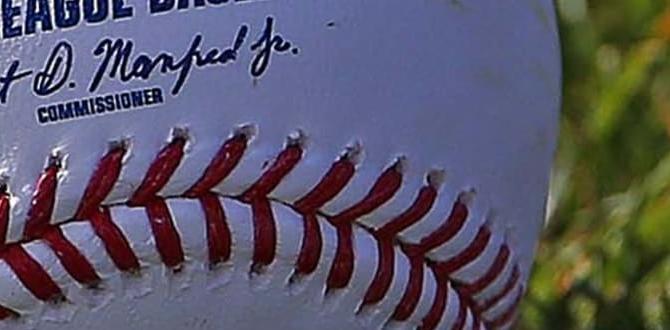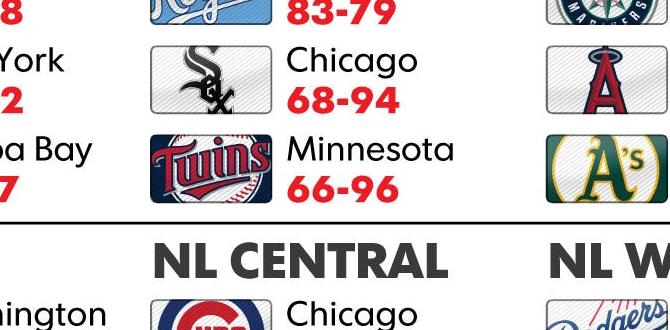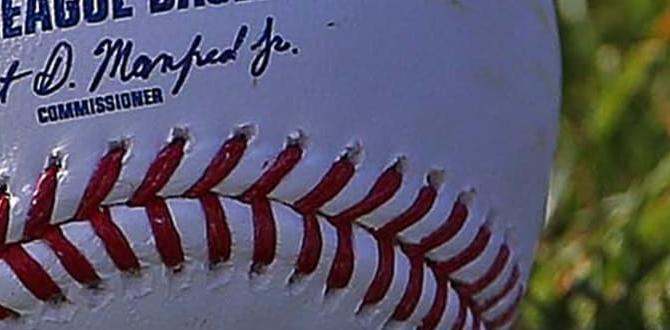Do you ever wonder how good your favorite baseball players really are? Statistics play a big role in understanding their skills. Each player has unique numbers that tell their story. For example, did you know that every hit, run, and strikeout counts towards their overall success? It’s almost like a treasure map leading to hidden talents.
Baseball statistics can seem complicated at first. But once you dive in, they become exciting! Every number has meaning. They help fans compare players, teams, and even seasons. Have you ever heard someone say they love a player because of their batting average? That’s statistics at work! It makes following the game so much more fun.
In this article, we will explore statistics for baseball players. You will learn how these numbers shape our view of the game. Get ready to uncover the secrets behind the stats that keep fans talking!
Comprehensive Statistics For Baseball Players Explained
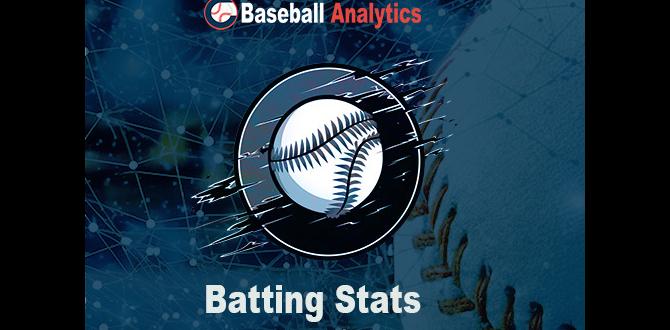
Statistics for Baseball Players
Baseball players rely on statistics to gauge their performance. Ever wonder how a player’s batting average showcases their hitting skills? Or how on-base percentage reveals their ability to get on base? Fans and coaches use these numbers to make decisions. Fun fact: the first recorded baseball stats date back to the 19th century! Understanding these stats can deepen your appreciation of the game and highlight players’ abilities and contributions on the field.Main Types of Baseball Statistics
Batting statistics (e.g., batting average, onbase percentage, slugging percentage). Pitching statistics (e.g., earned run average, WHIP, strikeouts).Baseball stats are like magic glasses that help us see how players perform. First, we have batting statistics. This includes batting average, which tells us how often a player gets a hit. Then there’s on-base percentage, showing how good they are at not getting out, and slugging percentage, which measures their power to hit for distance—think home runs! On the other hand, we have pitching statistics. The earned run average (ERA) shows how many runs a pitcher allows in a game. WHIP tells us how many runners they allow on base, and strikeouts show how many batters they send to the bench. It’s like a game of chess—each move counts!
| Statistic Type | Example |
|---|---|
| Batting Average | Hitting .300 |
| On-base Percentage | Getting on base 38% of the time |
| Slugging Percentage | Hitting for power effectively |
| Earned Run Average | 3.50 ERA |
| WHIP | 1.20 WHIP |
| Strikeouts | 10 strikeouts per game |
Advanced Metrics in Baseball
Explanation of advanced statistics (e.g., WAR, OPS+, FIP). Importance of advanced metrics for player evaluation.Baseball isn’t just about home runs and strikeouts. Advanced statistics take the game to new heights! Metrics like WAR (Wins Above Replacement) show how many wins a player adds compared to a replacement player. OPS+ combines on-base percentage and slugging percentage while adjusting for park factors. FIP (Fielding Independent Pitching) tells us how well a pitcher performs without relying on fielders. These stats help teams evaluate players better, like finding the hidden gems who can shine!
| Stat | What It Means |
|---|---|
| WAR | Measures overall value by wins added |
| OPS+ | Combines hitting stats, adjusts for conditions |
| FIP | Assesses pitcher’s skill, ignoring defense |
Are advanced metrics complicated? Maybe a little, but they help teams spot talented players. In baseball, it’s all about playing smart—like trying to steal second base when the catcher’s not looking!
The Role of Sabermetrics
Definition of sabermetrics and its impact on baseball analysis. Key sabermetric principles relevant to player performance.Sabermetrics is the study of baseball numbers to understand player performance. It helps teams make better choices by analyzing data. For example, knowing a player’s on-base percentage tells how good they are at getting on base. This kind of analysis can change how players are valued and selected.
- Player Evaluation: It helps see who performs best.
- Game Strategy: It suggests better tactics during games.
- Player Development: It shows areas where players can improve.
What are key sabermetric principles?
Key principles include on-base percentage, slugging percentage, and WAR (Wins Above Replacement). These statistics help teams pick stronger players and create better strategies.
Many teams now use sabermetrics. It’s not just about who hits home runs anymore. It’s about all the little things a player does to help the team win.
How to Interpret Player Statistics
Tips for analyzing a player’s season statistics. Contextual factors influencing player stats (e.g., ballpark effects, team dynamics).Understanding a player’s season stats can feel like cracking a secret code! Start by looking at key numbers like batting average and home runs. Each player’s performance can change depending on their ballpark or team dynamics. For example, a player might hit more home runs in a friendly park than in a big, windy stadium. So, check how their stats stack up with different teams and playing fields!
| Player | Home Runs | Batting Average | Ballpark Factor |
|---|---|---|---|
| Player A | 30 | .275 | 1.05 |
| Player B | 25 | .290 | 0.90 |
The fun part? Stats tell stories! They reveal how players shine or struggle. Look for patterns, and you might even find why they hit home runs like it is a game of pinball!
Utilizing Statistics for Player Comparisons
Methods for comparing players using statistics. Historical context and player comparisons over eras.Players can be compared using statistics like home runs, batting average, and earned run average (ERA). It’s like picking the best superhero based on their powers! Thanks to modern stats, we can analyze players from different eras. For example, comparing Babe Ruth’s home runs to modern players can spark fun debates. Is he better, or are players today just more fit? Let’s look at some key points in the table below!
| Player | Home Runs | Era |
|---|---|---|
| Babe Ruth | 714 | 1920s |
| Barry Bonds | 762 | 2000s |
| Aaron Judge | 62 | 2022 |
By using stats, we can have fun discussions over who really is the home run king. So, grab your popcorn and enjoy the debates!
Statistics and Player Development
How statistics inform training and improvement strategies. Use of data analytics in scouting and player acquisition.Using statistics is key to helping baseball players get better. Coaches look at player data to find out what skills need work. This helps create strong training plans. Teams now use data analytics in scouting. They can see how players might fit in their plans. This means picking the best players for the team. Smart use of numbers changes how players train and improve.
How do statistics help baseball players improve?
Statistics show players’ strengths and weaknesses, guiding their training efforts.
Key Benefits of Using Statistics:
- Helps spot areas for improvement.
- Informs training strategies.
- Guides team choices for new players.
By paying attention to numbers, teams can discover new talent. Good scouting now means more than watching games. It’s about understanding the numbers behind the players. Players who use stats to train improve faster.
Challenges in Baseball Statistics
Limitations of traditional statistics. Misinterpretation and misuse of data in baseball analysis.Baseball statistics can be tricky, like trying to catch a fly ball with one hand. Traditional stats often miss the full story. For example, a player’s batting average doesn’t show their power or skill in clutch moments. Misinterpreting this data can lead teams astray. Some folks think a high average guarantees a good player, but that’s like saying all ice cream tastes the same! Keep an eye on advanced metrics, as they provide a better picture.
| Traditional Statistics | What They Miss |
|---|---|
| Batting Average | Power and situation performance |
| Home Runs | On-base skills |
| Wins | Team effort and player contributions |
Baseball should be fun and smart! Relying solely on old-school numbers can lead to big blunders, like running in the wrong direction during a game. Understanding the data is key to winning. Let’s play ball with the right stats!
Future Trends in Baseball Statistics
Emerging technologies and their influence on baseball metrics. Predictions for the evolution of player statistics in the game.New tools can help teams track player performance in exciting ways. Wearable technology gathers data directly from players. This gives coaches real-time information to improve training. Video analysis also shows how players move and decide. In the future, we might see statistics for every pitch and swing. This will make understanding player skills even easier. Teams will likely focus on specific stats to find what helps them win.
What technologies are changing baseball metrics?
Wearable devices and video analysis are the main new tools affecting baseball statistics. They provide real data for player movements and performance.
- Wearable technology: Tracks player performance.
- Video analysis: Reveals player techniques.
- Advanced metrics: Offer deeper game insights.
Conclusion
In summary, statistics for baseball players help us understand their performance and skills. You can see how players hit, run, and field. This information makes watching games more fun! To learn more, check out player stats online or try keeping track during a game. By doing this, you’ll become a better fan and appreciate the game even more!FAQs
What Are The Key Statistics Used To Evaluate A Baseball Player’S Offensive Performance, And How Do They Differ Between Batting Average And On-Base Percentage?To see how good a baseball player is at hitting, we look at important numbers. Two key stats are batting average and on-base percentage. Batting average tells us how often a player gets a hit, like a fraction. On-base percentage shows how often a player gets on base, including walks. So, batting average is only for hits, while on-base percentage includes hits and walks.
Sure! Just let me know the question you want me to answer.
How Does A Pitcher’S Earned Run Average (Era) Impact Their Perceived Effectiveness Compared To Other Metrics Such As Whip (Walks Plus Hits Per Innings Pitched)?A pitcher’s earned run average (ERA) shows how many runs they allow each game. A lower ERA means they are doing really well. WHIP, which stands for walks plus hits per innings pitched, tells us how many runners reach base. Both numbers help us see how good a pitcher is, but ERA focuses more on runs allowed. So, a pitcher with a low ERA is often seen as more effective.
Sure! Please provide me with the question you’d like me to answer.
In What Ways Do Advanced Metrics Like War (Wins Above Replacement) And Ops+ Provide Deeper Insights Into A Player’S Overall Contribution To Their Team?Advanced metrics like WAR and OPS+ help us understand how valuable a player is. WAR means Wins Above Replacement. It shows how many extra wins a player brings to their team compared to a simple player. OPS+ measures a player’s hitting skills compared to others. Both these numbers give us a clear picture of how players help their teams win games.
Sure! I can help with that. Please provide the question you want me to answer.
How Can Defensive Statistics, Such As Fielding Percentage And The Ultimate Zone Rating (Uzr), Influence The Evaluation Of A Player’S Defensive Capabilities?Defensive statistics help us see how good a player is at fielding. Fielding percentage shows how many times a player catches the ball without making mistakes. The Ultimate Zone Rating (UZR) measures how many runs a player saves with their catches and throws. These numbers help coaches and fans understand if a player is strong defensively. Good stats mean a player is making a big difference in the game!
Sure, I can help with that! Please provide the question you want me to answer.
What Role Do Situational Statistics, Such As Performance With Runners In Scoring Position, Play In Assessing A Player’S Clutch Performance During Games?Situational statistics help us see how well a player does in important moments. One big moment is when there are runners in scoring position. This means there are players on base who can easily score. If a player hits well in these situations, it shows they can handle pressure. So, these stats help us decide if a player is good in crunch time.
{“@context”:”https://schema.org”,”@type”: “FAQPage”,”mainEntity”:[{“@type”: “Question”,”name”: “What Are The Key Statistics Used To Evaluate A Baseball Player’S Offensive Performance, And How Do They Differ Between Batting Average And On-Base Percentage?”,”acceptedAnswer”: {“@type”: “Answer”,”text”: “To see how good a baseball player is at hitting, we look at important numbers. Two key stats are batting average and on-base percentage. Batting average tells us how often a player gets a hit, like a fraction. On-base percentage shows how often a player gets on base, including walks. So, batting average is only for hits, while on-base percentage includes hits and walks.”}},{“@type”: “Question”,”name”: “”,”acceptedAnswer”: {“@type”: “Answer”,”text”: “Sure! Just let me know the question you want me to answer.”}},{“@type”: “Question”,”name”: “How Does A Pitcher’S Earned Run Average (Era) Impact Their Perceived Effectiveness Compared To Other Metrics Such As Whip (Walks Plus Hits Per Innings Pitched)?”,”acceptedAnswer”: {“@type”: “Answer”,”text”: “A pitcher’s earned run average (ERA) shows how many runs they allow each game. A lower ERA means they are doing really well. WHIP, which stands for walks plus hits per innings pitched, tells us how many runners reach base. Both numbers help us see how good a pitcher is, but ERA focuses more on runs allowed. So, a pitcher with a low ERA is often seen as more effective.”}},{“@type”: “Question”,”name”: “”,”acceptedAnswer”: {“@type”: “Answer”,”text”: “Sure! Please provide me with the question you’d like me to answer.”}},{“@type”: “Question”,”name”: “In What Ways Do Advanced Metrics Like War (Wins Above Replacement) And Ops+ Provide Deeper Insights Into A Player’S Overall Contribution To Their Team?”,”acceptedAnswer”: {“@type”: “Answer”,”text”: “Advanced metrics like WAR and OPS+ help us understand how valuable a player is. WAR means Wins Above Replacement. It shows how many extra wins a player brings to their team compared to a simple player. OPS+ measures a player’s hitting skills compared to others. Both these numbers give us a clear picture of how players help their teams win games.”}},{“@type”: “Question”,”name”: “”,”acceptedAnswer”: {“@type”: “Answer”,”text”: “Sure! I can help with that. Please provide the question you want me to answer.”}},{“@type”: “Question”,”name”: “How Can Defensive Statistics, Such As Fielding Percentage And The Ultimate Zone Rating (Uzr), Influence The Evaluation Of A Player’S Defensive Capabilities?”,”acceptedAnswer”: {“@type”: “Answer”,”text”: “Defensive statistics help us see how good a player is at fielding. Fielding percentage shows how many times a player catches the ball without making mistakes. The Ultimate Zone Rating (UZR) measures how many runs a player saves with their catches and throws. These numbers help coaches and fans understand if a player is strong defensively. Good stats mean a player is making a big difference in the game!”}},{“@type”: “Question”,”name”: “”,”acceptedAnswer”: {“@type”: “Answer”,”text”: “Sure, I can help with that! Please provide the question you want me to answer.”}},{“@type”: “Question”,”name”: “What Role Do Situational Statistics, Such As Performance With Runners In Scoring Position, Play In Assessing A Player’S Clutch Performance During Games?”,”acceptedAnswer”: {“@type”: “Answer”,”text”: “Situational statistics help us see how well a player does in important moments. One big moment is when there are runners in scoring position. This means there are players on base who can easily score. If a player hits well in these situations, it shows they can handle pressure. So, these stats help us decide if a player is good in crunch time.”}}]}

